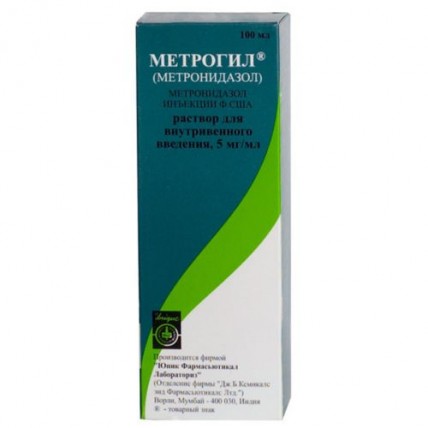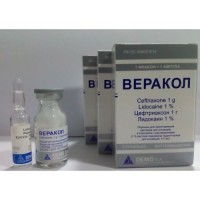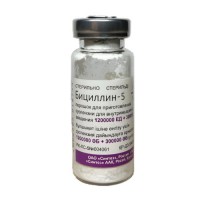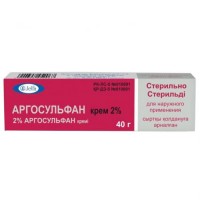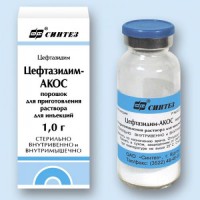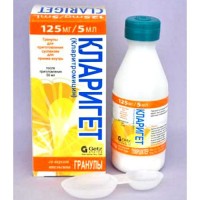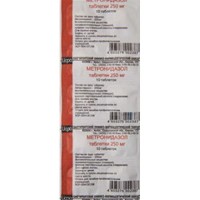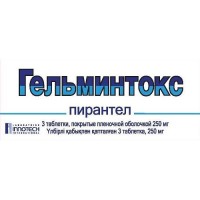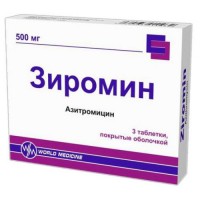Metrogil 5 mg / ml, 100 ml infusion solution
- $2.80
Out Of Stock
The instruction for medical use
of Metrogil Torgovoye medicine a name
Metrogil
Mezhdunarodnoye the unlicensed
name Metronidazole Dosage Form Solution for intravenous administration of 5 mg/ml - 100 ml
Structure
of 1 ml of solution contains
active agent - metronidazole - 5 mg
excipients: sodium chloride, citric acid monohydrate, dinatrium hydrophosphate anhydrous, water for injections.
The description
Transparent solution from colourless till pale yellow color
Pharmacotherapeutic group
Antibacterial drugs for system use. Imidazole derivatives. Metronidazole.
The ATX J01XD01 code
Pharmacological action
Pharmacokinetics
At intravenous administration of 500 mg of metronidazole within 20 minutes the concentration of drug in blood serum makes in 1 hour 35.2 mkg/ml, in 4 hours – 33.9 mkg/ml, in 8 hours – 25.7 mkg/ml. At normal bile production the concentration of metronidazole in bile after intravenous administration can exceed considerably concentration in blood plasma. In an organism about 30-60% of metronidazole by hydroxylation, oxidation and a glyukuronirovaniye are metabolized. The main metabolite (2 oxymetronidazole) also has antiprotozoan and antimicrobial effect. T1/2 at normal function of a liver - 8 hours (from 6 to 12 hours), at alcoholic damage of a liver of-18 hours (from 10 to 29 hours), at newborns: been born at duration of gestation – 28-30 weeks - about 75 hours, 32-35 weeks - 35 hours, 36-40 weeks - 25 hours. It is removed by kidneys of 60 - 80% (20% in not changed look), through intestines – 6 - 15%. Renal clearance - 10.2 ml/min. At patients with a renal failure after repeated introduction the metronidazole kumulirovaniye in blood serum can be observed (in this connection at patients with a heavy renal failure the frequency of reception should be reduced). Metronidazole and the main metabolites quickly are removed from blood at a hemodialysis (T1/2 is reduced till 2.6 o'clock). At peritoneal dialysis it is removed in insignificant quantities.
A pharmacodynamics
Metrogil - antiprotozoan and antimicrobial drug, derivative 5 nitroimidazoles. The mechanism of action consists in biochemical restoration 5 nitrogroups of metronidazole intracellular transport proteins of anaerobic microorganisms and protozoa. The restored 5 nitrogroup of metronidazole interacts with DNA of a cell of microorganisms, inhibiting synthesis of their nucleic acids that leads to death of bacteria.
Entamoeba histolytica, Gardnerella vaginalis, Giardia intestinalis, Lamblia spp. and also strict anaerobes of Bacteroides spp is active concerning Trichomonas vaginalis. (including Bacteroides fragilis, Bacteroides distasonis, Bacteroides ovatus, Bacteroides thetaiotaomicron, Bacteroides vulgatus), Fusobacterium spp., Veillonella spp., Prevotella (Prevotella bivia, Prevotella buccae, Prevotella disiens) and some gram-positive microorganisms (Eubacter spp., Clostridium spp., Peptococcus spp., Peptostreptococcus spp.).
In combination with amoxicillin shows activity concerning Helicobacter pylori (amoxicillin suppresses development of resistance to metronidazole).
Aerobic microorganisms and facultative anaerobes, but in the presence of the mixed flora are insensitive to metronidazole (aerobes and anaerobe bacterias) metronidazole works sinergidno with the antibiotics effective against usual aerobes.
Increases sensitivity of tumors to radiation, causes disulfiramopodobny reactions, stimulates reparative processes.
Indications
It is recommended for treatment of the infections caused by microorganisms, sensitive to drug:
- prevention and treatment of mephitic gangrenes at surgical interventions, mainly, on abdominal organs and urinary tract
- combination therapy of the heavy mixed aerobic-anaerobic infections
- sepsis
- peritonitis
- osteomyelitis
- gynecologic infections
- abscesses of a small pelvis
- brain abscesses
- the abscessing pneumonia
- gas gangrene
- infections of skin and soft tissues, bones and joints
Routes of administration and doses
Intravenous administration of drug is shown for therapy of the established infection sensitive to metronidazole at a heavy course and also in the absence of a possibility of administration of drug inside.
To adults and children 12 years in an initial dose of 500 mg intravenously by drop infusion (duration of infusions – 30 - 40 minutes), each 8 hours with a speed of 5 ml/min. are more senior. At good tolerance after the first 2 - 3 infusions pass to jet introduction. The maximum daily dose - 4 g. According to indications carry out transition to the supporting intake.
To children aged from 8 weeks up to 12 years – the daily dose makes 20-30 mg/kg in the form of a single dose or – to 7.5 mg/kg there are each 8 hours. The daily dose can be increased up to 40 mg/kg, depending on weight of an infection.
To children to 8-week age – 15 mg/kg in the form of a single dose daily or to 7.5 mg/kg are each 12 hours.
Course of treatment of 7 days.
At newborns to 40 weeks the accumulation of metronidazole can happen to gestation term within the first week of life therefore it is preferable to carry out monitoring of concentration of metronidazole in blood serum within several days of therapy.
At it is purulent - septic diseases usually conduct 1 course of treatment.
In the preventive purposes to adults and children 12 years are more senior appoint intravenously by drop infusion 500 mg every 8 hours on the eve of operation, in day of operation and next day, with the subsequent transition to maintenance therapy inside. The patient with chronic kidney disease and clearance of creatinine less than 30 ml/min. and/or a liver failure the maximum daily dose - no more than 1 g, frequency rate of reception - 2 times a day. Considerable accumulation of metronidazole can be observed at patients with hepatic encephalopathy. Owing to growth of concentration of metronidazole in blood plasma, encephalopathy symptoms can amplify. If necessary the daily dose can be reduced up to 1/3 and to apply once a day.
At patients of advanced age the pharmacokinetics of metronidazole can change in this connection there can be a need of control of level of metronidazole for blood serum.
Treatment of mephitic gangrenes within 7-10 days has to be satisfactory for most of patients, but depending on clinical and bacteriological assessment, treatment extension, for example, for elimination of the infection creating threat of endogenous repeated infection with anaerobic activators from intestines, bodies of a small pelvis is possible.
At the mixed aerobic-anaerobic infections Metrogil solution can be applied to intravenous administration in a combination with parenteral antibiotics, without mixing drugs at introduction.
Metrogil solution for intravenous administration cannot be mixed with other drugs.
Side effects
Very often (≥1/10)
- a headache
- nausea
Often (≥1/100 to & lt, 1/10)
- a loss of appetite, dryness in a mouth, an abdominal pain, a dysgeusia (metal smack), diarrhea
Infrequently (≥1/1000 to & lt, 1/100)
- anorexia, vomiting, a language oblozhennost
- dizziness, an incoordination, drowsiness
- temperature increase
- a dermahemia
- congestion of a nose
- an arthralgia
- flattening of a tooth of T on the ECG
- a dysuria, cystitis, a polyuria, urine incontinence, candidiasis
- urticaria, skin rash,
naggers Redko (≥1/10000 to & lt, 1/1000)
- irritability, a depression, hyperexcitability, weakness, insomnia, confusion of consciousness, an ataxy, spasms, hallucinations, peripheral neuropathy (at prolonged use in high doses), encephalopathy, stiff neck, a subacute cerebellar syndrome (dysarthtia, a nystagmus, a tremor)
- dryness of a mucous membrane, a glossitis, stomatitis, mucositis, decolouration of language
- constipations
- pancreatitis
- burning in a vagina and an urethra, coloring of urine in red brown color
is Very rare (& lt, 1/10000)
- a neutropenia (leukopenia), thrombocytopenia, an agranulocytosis, a pancytopenia
- a polymorphic erythema, anaphylactic reactions
- thrombophlebitis (pain, hyperaemia or puffiness in the place of an injection)
- cholestatic hepatitis, increase in activity of liver enzymes, a liver failure
- a gynecomastia
- a disorder of vision, shortsightedness, a diplopia, changes of color perception a neuropathy of an optic nerve, neuritis
- aseptic meningitis
- superinfection
These phenomena usually disappear with decrease in the entered dose or after end of a course of therapy.
Contraindications
- hypersensitivity to metronidazole or other derivatives of a nitroimidazole
- organic lesions of the central nervous system, including epilepsy
- a liver failure (in case of purpose of high doses)
- blood diseases, including a leukopenia in the anamnesis
- pregnancy (I trimester) and the lactation period
- the combined reception with Disulfiramum, alcohol
- use for children and teenagers up to 18 years in a combination with amoxicillin
Metrogil for intravenous administration is not recommended to mix Medicinal interactions with other medicines!
Simultaneous administration of cyclosporine with metronidazole can lead to increase in level of cyclosporine in plasma that demands laboratory control (determination of level of cyclosporine in blood plasma).
At simultaneous use with Amiodaronum, lengthening of an interval of QT and torsade de pointes in this connection it is reasonable to carry out monitoring of an interval of QT on the ECG can be observed. Patients who are treated on an outpatient basis need to recommend to see a doctor at emergence of symptoms which can indicate torsade de pointes, such as dizziness, cardiopalmus or loss of consciousness.
Metrogil strengthens effect of indirect anticoagulants that leads to increase in time of formation of a prothrombin.
Similar to Disulfiramum causes intolerance of alcohol.
Simultaneous use with Disulfiramum can lead to development of various neurologic symptoms (an interval between appointment - not less than 2 weeks).
Cimetidinum suppresses metronidazole metabolism that can lead to increase in its concentration in blood serum and to increase in risk of development of by-effects.
Simultaneous use of metronidazole with busulfany can increase concentration of the last considerably. Due to the potential risk of the heavy toxic reactions and a lethal outcome connected with growth of plasma levels of a busulfan it is necessary to avoid its simultaneous use with metronidazole.
Metronidazole can suppress metabolism of carbamazepine and thereof to increase its plasma concentration.
Some antibacterial drugs in some cases can reduce efficiency of oral contraceptives, influencing bacterial hydrolysis of steroid conjugates in intestines and thus, reducing repeated absorption of not conjugated steroids. Therefore, plasma levels of active steroids decrease. This interaction can be noted at women with the high level of discharge of steroid conjugates with bile. The known cases of inefficiency of oral contraceptives were connected with use of various antibacterial agents, including ampicillin, amoxicillin, tetracycline and also metronidazole.
Metronidazole reduces clearance of a 5-ftoruratsil and as a result increases its toxicity.
Co-administration of the medicines stimulating enzymes of microsomal oxidation in a liver (phenobarbital, Phenytoinum) can accelerate metronidazole elimination therefore its concentration in blood plasma goes down.
Simultaneous use of metronidazole with takrolimusy can lead to growth of concentration of the last in blood. The probable mechanism of suppression of hepatic metabolism of a takrolimus is connected with CYP enzyme 3A4. In this connection, it is regularly necessary to control the level of a takrolimus in blood, function of kidneys and according to a dosage, especially at the beginning of therapy cancellation by metronidazole to the patients stabilized on the mode of reception of a takrolimus.
At a concomitant use with the drugs Li + concentration of the last in plasma can increase and amplify development of symptoms of intoxication.
Metrogil bromide with not depolarizing muscle relaxants (a vekuroniya is not recommended to combine).
Streptocides and antibiotics strengthen antimicrobial action of Metrogil.
Special instructions
during treatment the alcohol intake is contraindicated (possibly development of disulfiramopodobny reactions: abdominal pain of spastic character, nausea, vomiting, a headache, sudden rush of blood suit).
Patients with a porphyria are not recommended to apply metronidazole.
At long therapy the systematic control of a picture of peripheral blood is necessary.
At a leukopenia the possibility of continuation of treatment depends on risk of development of infectious process.
With care patients should appoint drug with the disturbance of a hematopoiesis inclined to appearance of hypostases and also to the patients receiving therapy by glucocorticosteroids. It is necessary to avoid a concomitant use of metronidazole and indirect anticoagulants. And in need of their joint appointment it is necessary to control carefully a prothrombin time and to establish the corresponding dose of anticoagulative means.
At administration of metronidazole, cases of aseptic meningitis were registered. Emergence of symptoms of meningitis happens within several hours after administration of drug and completely stop after the end of introduction.
Metronidazole should be applied with care at patients with an active chronic or serious illness of central nervous system in connection with risk of development of neurologic complications. Emergence of an ataxy, dizziness and any other deterioration in the neurologic status of patients demands the treatment termination. Symptoms from central nervous system, as a rule, are reversible during from several days to several weeks after metronidazole phase-out.
During treatment by metronidazole symptoms of a candidosis infection can appear.
In case of simultaneous carrying out to the patient of a hemodialysis, it is necessary to remember reduction of elimination half-life of metronidazole. In such cases, after carrying out a hemodialysis the additional administration of drug can be required.
At the patients who are not on a hemodialysis at clearance of creatinine lower than 10 ml/min. can collect metronidazole metabolites, in such cases carrying out a hemodialysis can be required, peritoneal dialysis is inefficient.
Metronidazole can immobilize treponemas and lead to the false positive test of Nelson.
Paints urine in dark color.
Pregnancy
Metronidazole gets through a gemato-placental barrier.
Researches on pregnant women were not conducted, in II and III trimester of pregnancy drug is appointed only according to vital indications.
Features of influence of medicine on ability to run the vehicle or potentially dangerous mechanisms.
Some patients, mainly in an initiation of treatment, can have a drowsiness and dizziness. In this connection, it is necessary to observe precautionary measures during the driving and work with mechanisms.
The form of release and packing
On 100 ml of solution place in a transparent plastic bottle. On one bottle packed into a cellophane wrapper together with the instruction for medical use in the state and Russian languages place in a cardboard pack.
3 years
not to use a period of storage after the termination of the expiration date specified on packing.
To Store storage conditions at a temperature not above 30 °C in the place protected from light.
Not to freeze.
To store in the places inaccessible for children!
Release from drugstores
According to the prescription
Is made
by Unique Pharmaceutical Laboratories
(Department of firm "J.B. Kemikals and Pharmasyyutikals Ltd.")
Vorley, Mumbai 400,030, India
the Organization accepting from consumers of a claim (offer) on quality of drug in the territory of the Republic of Kazakhstan
KAZDINFARMA LLP
050050, Republic of Kazakhstan, Almaty, Lobachevsky St., 78
ph./fax: 727 233 65 50, e-mail:
To Develop kazdinfarma@gmail.com
of Metrogil Torgovoye medicine a name
Metrogil
Mezhdunarodnoye the unlicensed
name Metronidazole Dosage Form Solution for intravenous administration of 5 mg/ml - 100 ml
Structure
of 1 ml of solution contains
active agent - metronidazole - 5 mg
excipients: sodium chloride, citric acid monohydrate, dinatrium hydrophosphate anhydrous, water for injections.
The description
Transparent solution from colourless till pale yellow color
Pharmacotherapeutic group
Antibacterial drugs for system use. Imidazole derivatives. Metronidazole.
The ATX J01XD01 code
Pharmacological action
Pharmacokinetics
At intravenous administration of 500 mg of metronidazole within 20 minutes the concentration of drug in blood serum makes in 1 hour 35.2 mkg/ml, in 4 hours – 33.9 mkg/ml, in 8 hours – 25.7 mkg/ml. At normal bile production the concentration of metronidazole in bile after intravenous administration can exceed considerably concentration in blood plasma. In an organism about 30-60% of metronidazole by hydroxylation, oxidation and a glyukuronirovaniye are metabolized. The main metabolite (2 oxymetronidazole) also has antiprotozoan and antimicrobial effect. T1/2 at normal function of a liver - 8 hours (from 6 to 12 hours), at alcoholic damage of a liver of-18 hours (from 10 to 29 hours), at newborns: been born at duration of gestation – 28-30 weeks - about 75 hours, 32-35 weeks - 35 hours, 36-40 weeks - 25 hours. It is removed by kidneys of 60 - 80% (20% in not changed look), through intestines – 6 - 15%. Renal clearance - 10.2 ml/min. At patients with a renal failure after repeated introduction the metronidazole kumulirovaniye in blood serum can be observed (in this connection at patients with a heavy renal failure the frequency of reception should be reduced). Metronidazole and the main metabolites quickly are removed from blood at a hemodialysis (T1/2 is reduced till 2.6 o'clock). At peritoneal dialysis it is removed in insignificant quantities.
A pharmacodynamics
Metrogil - antiprotozoan and antimicrobial drug, derivative 5 nitroimidazoles. The mechanism of action consists in biochemical restoration 5 nitrogroups of metronidazole intracellular transport proteins of anaerobic microorganisms and protozoa. The restored 5 nitrogroup of metronidazole interacts with DNA of a cell of microorganisms, inhibiting synthesis of their nucleic acids that leads to death of bacteria.
Entamoeba histolytica, Gardnerella vaginalis, Giardia intestinalis, Lamblia spp. and also strict anaerobes of Bacteroides spp is active concerning Trichomonas vaginalis. (including Bacteroides fragilis, Bacteroides distasonis, Bacteroides ovatus, Bacteroides thetaiotaomicron, Bacteroides vulgatus), Fusobacterium spp., Veillonella spp., Prevotella (Prevotella bivia, Prevotella buccae, Prevotella disiens) and some gram-positive microorganisms (Eubacter spp., Clostridium spp., Peptococcus spp., Peptostreptococcus spp.).
In combination with amoxicillin shows activity concerning Helicobacter pylori (amoxicillin suppresses development of resistance to metronidazole).
Aerobic microorganisms and facultative anaerobes, but in the presence of the mixed flora are insensitive to metronidazole (aerobes and anaerobe bacterias) metronidazole works sinergidno with the antibiotics effective against usual aerobes.
Increases sensitivity of tumors to radiation, causes disulfiramopodobny reactions, stimulates reparative processes.
Indications
It is recommended for treatment of the infections caused by microorganisms, sensitive to drug:
- prevention and treatment of mephitic gangrenes at surgical interventions, mainly, on abdominal organs and urinary tract
- combination therapy of the heavy mixed aerobic-anaerobic infections
- sepsis
- peritonitis
- osteomyelitis
- gynecologic infections
- abscesses of a small pelvis
- brain abscesses
- the abscessing pneumonia
- gas gangrene
- infections of skin and soft tissues, bones and joints
Routes of administration and doses
Intravenous administration of drug is shown for therapy of the established infection sensitive to metronidazole at a heavy course and also in the absence of a possibility of administration of drug inside.
To adults and children 12 years in an initial dose of 500 mg intravenously by drop infusion (duration of infusions – 30 - 40 minutes), each 8 hours with a speed of 5 ml/min. are more senior. At good tolerance after the first 2 - 3 infusions pass to jet introduction. The maximum daily dose - 4 g. According to indications carry out transition to the supporting intake.
To children aged from 8 weeks up to 12 years – the daily dose makes 20-30 mg/kg in the form of a single dose or – to 7.5 mg/kg there are each 8 hours. The daily dose can be increased up to 40 mg/kg, depending on weight of an infection.
To children to 8-week age – 15 mg/kg in the form of a single dose daily or to 7.5 mg/kg are each 12 hours.
Course of treatment of 7 days.
At newborns to 40 weeks the accumulation of metronidazole can happen to gestation term within the first week of life therefore it is preferable to carry out monitoring of concentration of metronidazole in blood serum within several days of therapy.
At it is purulent - septic diseases usually conduct 1 course of treatment.
In the preventive purposes to adults and children 12 years are more senior appoint intravenously by drop infusion 500 mg every 8 hours on the eve of operation, in day of operation and next day, with the subsequent transition to maintenance therapy inside. The patient with chronic kidney disease and clearance of creatinine less than 30 ml/min. and/or a liver failure the maximum daily dose - no more than 1 g, frequency rate of reception - 2 times a day. Considerable accumulation of metronidazole can be observed at patients with hepatic encephalopathy. Owing to growth of concentration of metronidazole in blood plasma, encephalopathy symptoms can amplify. If necessary the daily dose can be reduced up to 1/3 and to apply once a day.
At patients of advanced age the pharmacokinetics of metronidazole can change in this connection there can be a need of control of level of metronidazole for blood serum.
Treatment of mephitic gangrenes within 7-10 days has to be satisfactory for most of patients, but depending on clinical and bacteriological assessment, treatment extension, for example, for elimination of the infection creating threat of endogenous repeated infection with anaerobic activators from intestines, bodies of a small pelvis is possible.
At the mixed aerobic-anaerobic infections Metrogil solution can be applied to intravenous administration in a combination with parenteral antibiotics, without mixing drugs at introduction.
Metrogil solution for intravenous administration cannot be mixed with other drugs.
Side effects
Very often (≥1/10)
- a headache
- nausea
Often (≥1/100 to & lt, 1/10)
- a loss of appetite, dryness in a mouth, an abdominal pain, a dysgeusia (metal smack), diarrhea
Infrequently (≥1/1000 to & lt, 1/100)
- anorexia, vomiting, a language oblozhennost
- dizziness, an incoordination, drowsiness
- temperature increase
- a dermahemia
- congestion of a nose
- an arthralgia
- flattening of a tooth of T on the ECG
- a dysuria, cystitis, a polyuria, urine incontinence, candidiasis
- urticaria, skin rash,
naggers Redko (≥1/10000 to & lt, 1/1000)
- irritability, a depression, hyperexcitability, weakness, insomnia, confusion of consciousness, an ataxy, spasms, hallucinations, peripheral neuropathy (at prolonged use in high doses), encephalopathy, stiff neck, a subacute cerebellar syndrome (dysarthtia, a nystagmus, a tremor)
- dryness of a mucous membrane, a glossitis, stomatitis, mucositis, decolouration of language
- constipations
- pancreatitis
- burning in a vagina and an urethra, coloring of urine in red brown color
is Very rare (& lt, 1/10000)
- a neutropenia (leukopenia), thrombocytopenia, an agranulocytosis, a pancytopenia
- a polymorphic erythema, anaphylactic reactions
- thrombophlebitis (pain, hyperaemia or puffiness in the place of an injection)
- cholestatic hepatitis, increase in activity of liver enzymes, a liver failure
- a gynecomastia
- a disorder of vision, shortsightedness, a diplopia, changes of color perception a neuropathy of an optic nerve, neuritis
- aseptic meningitis
- superinfection
These phenomena usually disappear with decrease in the entered dose or after end of a course of therapy.
Contraindications
- hypersensitivity to metronidazole or other derivatives of a nitroimidazole
- organic lesions of the central nervous system, including epilepsy
- a liver failure (in case of purpose of high doses)
- blood diseases, including a leukopenia in the anamnesis
- pregnancy (I trimester) and the lactation period
- the combined reception with Disulfiramum, alcohol
- use for children and teenagers up to 18 years in a combination with amoxicillin
Metrogil for intravenous administration is not recommended to mix Medicinal interactions with other medicines!
Simultaneous administration of cyclosporine with metronidazole can lead to increase in level of cyclosporine in plasma that demands laboratory control (determination of level of cyclosporine in blood plasma).
At simultaneous use with Amiodaronum, lengthening of an interval of QT and torsade de pointes in this connection it is reasonable to carry out monitoring of an interval of QT on the ECG can be observed. Patients who are treated on an outpatient basis need to recommend to see a doctor at emergence of symptoms which can indicate torsade de pointes, such as dizziness, cardiopalmus or loss of consciousness.
Metrogil strengthens effect of indirect anticoagulants that leads to increase in time of formation of a prothrombin.
Similar to Disulfiramum causes intolerance of alcohol.
Simultaneous use with Disulfiramum can lead to development of various neurologic symptoms (an interval between appointment - not less than 2 weeks).
Cimetidinum suppresses metronidazole metabolism that can lead to increase in its concentration in blood serum and to increase in risk of development of by-effects.
Simultaneous use of metronidazole with busulfany can increase concentration of the last considerably. Due to the potential risk of the heavy toxic reactions and a lethal outcome connected with growth of plasma levels of a busulfan it is necessary to avoid its simultaneous use with metronidazole.
Metronidazole can suppress metabolism of carbamazepine and thereof to increase its plasma concentration.
Some antibacterial drugs in some cases can reduce efficiency of oral contraceptives, influencing bacterial hydrolysis of steroid conjugates in intestines and thus, reducing repeated absorption of not conjugated steroids. Therefore, plasma levels of active steroids decrease. This interaction can be noted at women with the high level of discharge of steroid conjugates with bile. The known cases of inefficiency of oral contraceptives were connected with use of various antibacterial agents, including ampicillin, amoxicillin, tetracycline and also metronidazole.
Metronidazole reduces clearance of a 5-ftoruratsil and as a result increases its toxicity.
Co-administration of the medicines stimulating enzymes of microsomal oxidation in a liver (phenobarbital, Phenytoinum) can accelerate metronidazole elimination therefore its concentration in blood plasma goes down.
Simultaneous use of metronidazole with takrolimusy can lead to growth of concentration of the last in blood. The probable mechanism of suppression of hepatic metabolism of a takrolimus is connected with CYP enzyme 3A4. In this connection, it is regularly necessary to control the level of a takrolimus in blood, function of kidneys and according to a dosage, especially at the beginning of therapy cancellation by metronidazole to the patients stabilized on the mode of reception of a takrolimus.
At a concomitant use with the drugs Li + concentration of the last in plasma can increase and amplify development of symptoms of intoxication.
Metrogil bromide with not depolarizing muscle relaxants (a vekuroniya is not recommended to combine).
Streptocides and antibiotics strengthen antimicrobial action of Metrogil.
Special instructions
during treatment the alcohol intake is contraindicated (possibly development of disulfiramopodobny reactions: abdominal pain of spastic character, nausea, vomiting, a headache, sudden rush of blood suit).
Patients with a porphyria are not recommended to apply metronidazole.
At long therapy the systematic control of a picture of peripheral blood is necessary.
At a leukopenia the possibility of continuation of treatment depends on risk of development of infectious process.
With care patients should appoint drug with the disturbance of a hematopoiesis inclined to appearance of hypostases and also to the patients receiving therapy by glucocorticosteroids. It is necessary to avoid a concomitant use of metronidazole and indirect anticoagulants. And in need of their joint appointment it is necessary to control carefully a prothrombin time and to establish the corresponding dose of anticoagulative means.
At administration of metronidazole, cases of aseptic meningitis were registered. Emergence of symptoms of meningitis happens within several hours after administration of drug and completely stop after the end of introduction.
Metronidazole should be applied with care at patients with an active chronic or serious illness of central nervous system in connection with risk of development of neurologic complications. Emergence of an ataxy, dizziness and any other deterioration in the neurologic status of patients demands the treatment termination. Symptoms from central nervous system, as a rule, are reversible during from several days to several weeks after metronidazole phase-out.
During treatment by metronidazole symptoms of a candidosis infection can appear.
In case of simultaneous carrying out to the patient of a hemodialysis, it is necessary to remember reduction of elimination half-life of metronidazole. In such cases, after carrying out a hemodialysis the additional administration of drug can be required.
At the patients who are not on a hemodialysis at clearance of creatinine lower than 10 ml/min. can collect metronidazole metabolites, in such cases carrying out a hemodialysis can be required, peritoneal dialysis is inefficient.
Metronidazole can immobilize treponemas and lead to the false positive test of Nelson.
Paints urine in dark color.
Pregnancy
Metronidazole gets through a gemato-placental barrier.
Researches on pregnant women were not conducted, in II and III trimester of pregnancy drug is appointed only according to vital indications.
Features of influence of medicine on ability to run the vehicle or potentially dangerous mechanisms.
Some patients, mainly in an initiation of treatment, can have a drowsiness and dizziness. In this connection, it is necessary to observe precautionary measures during the driving and work with mechanisms.
The form of release and packing
On 100 ml of solution place in a transparent plastic bottle. On one bottle packed into a cellophane wrapper together with the instruction for medical use in the state and Russian languages place in a cardboard pack.
3 years
not to use a period of storage after the termination of the expiration date specified on packing.
To Store storage conditions at a temperature not above 30 °C in the place protected from light.
Not to freeze.
To store in the places inaccessible for children!
Release from drugstores
According to the prescription
Is made
by Unique Pharmaceutical Laboratories
(Department of firm "J.B. Kemikals and Pharmasyyutikals Ltd.")
Vorley, Mumbai 400,030, India
the Organization accepting from consumers of a claim (offer) on quality of drug in the territory of the Republic of Kazakhstan
KAZDINFARMA LLP
050050, Republic of Kazakhstan, Almaty, Lobachevsky St., 78
ph./fax: 727 233 65 50, e-mail:
To Develop kazdinfarma@gmail.com
